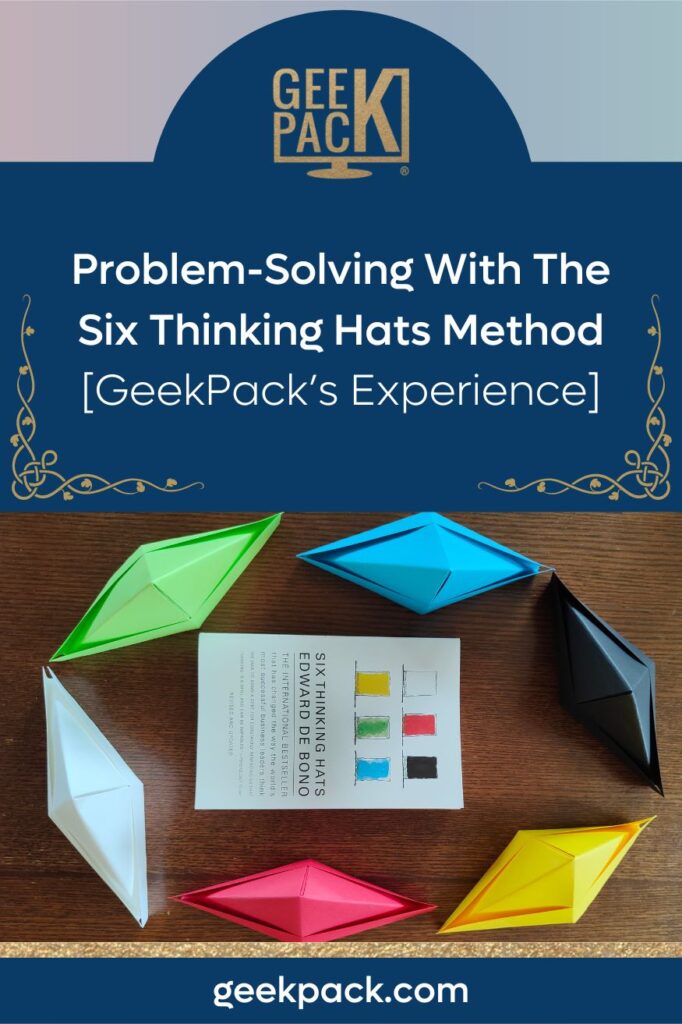
‘Thinking is the ultimate human resource."
This sentence comes from Edward de Bono's book Six Thinking Hats.
We’ve used this book in our first-ever team retreat as it teaches a very interesting way of thinking and solving problems.
There are things I love about it, and there are moments I don’t think it works so well.
Edward de Bono's method uses parallel thinking in a way that makes a decision-making process more effective, whether in group meetings or personal dilemmas.
By donning different "hats," you can explore different perspectives, where each hat has its purpose.
But first, let’s talk about parallel thinking and why this is important.
“Parallel thinking means that at any moment everyone is looking in the same direction.”
Imagine we're trying to solve a puzzle together.
Instead of arguing over which piece fits where, we decided to work together and share ideas on how each piece might connect, exploring every angle together.
That's pretty much what parallel thinking is all about.
It makes us fight our argumentative instincts, so the solution is our only focus.
Edward de Bono suggests that by nature, we're wired to be argumentative. It's like our brains light up at the chance to spot flaws or counter with our own ideas.
While this might make for interesting dinner conversations, it's not always our best friend when it comes to solving problems together.
This argumentative instinct can lead to a couple of hiccups in problem-solving:
What's cool about the Six Thinking Hats method is that it encourages us to switch off that default debate mode.
By wearing the same "hat" at the same time, we're not fighting to get our voices heard.
Instead, we're collectively exploring different aspects of the problem—factually, creatively, optimistically, and so on.

As the book name suggests, there are six different hats and each of them has a different purpose.
The neutral one.
It keeps you objective, and it’s all about facts and figures. This is about things you know are true, no assumptions or feelings. It’s neither negative nor positive, simply facts.
The emotional one.
When you wear the red hat you don’t need to justify anything. This is the moment to use your gut feeling and just spill it out, no explanation necessary.
Careful and cautious, the "devil's advocate" hat.
Also known as the easiest one because as stated before, we are argumentative beings. We’re conditioned to disagree. It’s like our natural habitat.
But this is not a bad hat, it’s quite an important one. It’s about what can go wrong, what may not work and it’s meant to protect us from making bad decisions.
It’s very important that everything stated under the black hat can be backed up with facts. If there are no facts, then it’s a feeling. And that's the red hat.
The sunny and positive one.
It’s the opposite of the black hat. Here you’ll only focus on what can go right. It’s your time to be optimistic and look for opportunities.
The creative one.
Here there’s no such thing as a silly or crazy idea - there’s no judgment. It’s highly encouraged to think outside of the box and put all your ideas out there even when they don’t make sense.
The reason for that is that even though the original idea may not make sense at first glance, it can lead to a different way of thinking.
And eventually, leads to an idea that’s innovative and that does make sense.
The organizing hat.
The blue hat is the one that leads the show. The one that ‘controls’ the thinking.
It sets the focus, it defines the problems and it's also the hat that keeps the other hats in line.
If someone says something negative when using a yellow hat, the blue hat thinker is responsible for getting them back on track.
And the blue hat also dictates the order the hats will be used.

It worked really well for us when we had a single thing to figure out.
The more specific the better - as an example, we need to make $100k in 6 weeks. How do we do that?
Using the hats to solve a specific problem worked really well in our experience.
We tried using the hats to figure out what our yearly goals were, but there wasn’t a specific problem to solve.
We didn’t know where to begin, so we ended up going in circles for a long time, without a real focus.
The hats kept us on track, it dictated where all of our brain power was going. It’s like going through a decision-making journey with a map, if that makes sense.
We looked at data, we looked at what has worked and what hasn’t, and from there, it was easier to come up with different ideas and narrow them down.
One thing we realized after a while was that we could stay on one hat for hours. There’s always something to say.
So saying from the start, we have 20 minutes for this hat worked well. If the discussion was still productive, then we’d extend - but at least we had this sort of time guideline to keep us moving.
It was our first time using the hats, so it wasn’t perfect and it took us some time to figure out the best way of using them. But I really think towards the end of the retreat we got much better.
We put them on the easel so we all knew the hat we were working with at the time.
Though it’s not the most practical method, as it does take some time to get everyone used to it, there are a lot of benefits from this way of thinking.
Next time we’re brainstorming or tackling a problem, remembering our natural tendency to jump into debate mode could be the first step in trying something different.
By acknowledging this and opting for a parallel thinking approach, we might just find ourselves not only solving problems more effectively but also enjoying the process a whole lot more.


I’d love to hear from you - have you ever used the Six Thinking Hats method? Or do you have any insights on why this may or may not work? Join our FREE facebook community and let me know!



148 Discovery Call Questions you can use to mix & match the perfect profitable call!





Copyright © 2021 - 2024 GeekPack, Inc| All Rights Reserved | Design by Soul Alchemy Branding![]() | Built by GeekPack®
| Built by GeekPack® Privacy Policy | Terms & Conditions | Earnings & Affiliate Disclaimers | Refund Policy | Sitemap
Privacy Policy | Terms & Conditions | Earnings & Affiliate Disclaimers | Refund Policy | Sitemap